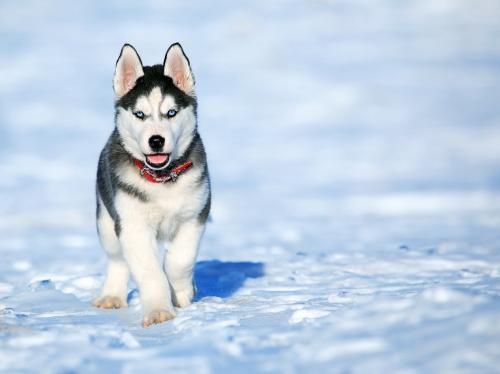Famous dog breeds are of Russian origin

In the Russian Federation, a country known for having the harshest climates in the world, dogs have long been tamed by humans to pull sleds across snow covered areas. Now, they are still the loyal and lovely friends of every family everywhere in the world.
HUSKY SIBIR CHAIN
One of the best-known Russian breeds is the Husky Sibir. This breed is native to the northeastern region of Sibir in Russia. After being brought to Alaska during the gold mining period, they gradually gained popularity in the United States and Canada and were pets in many families around the world.
Husky Sibir has a thick coat of 2 layers. A thick and short undercoat is lined on the inside. A thinner and longer coat is covered on the outside. This coat is thicker than most other breeds. Because their ancestors lived in the harshest icy regions in the world.
Their size depends on the medium form. A purebred husky male from 53 cm - 58 cm high and weighs from 20 to 27 kg. Meanwhile, females are smaller, 51 - 56 cm tall and weigh from 16-23 kg.
Most husky has feathers on the legs, snout, end spots white tail. Remaining colors can be black (most common), brown, gray, agouti (rare).
Husky's eyes are almond shaped and slightly slanted. This makes their faces a bit serious and humorous.
The nose of the husky sibir has a color associated with the coat color. Gray hair - black nose, black hair - brown nose, brown hair - dark red nose, white hair - light gray nose.
The tail of husky is long and very hairy. They often turn their tails off if there is no activity and curl up on their backs when running. This is also a common feature of cold country breeds.
In addition to the pretty impressive face, the personality is also a feature that many people like to raise a husky. As an energetic species, they are very energetic and love to run. Therefore, husky needs a strict training regime and limit them to too long in narrow spaces. Your husky also needs to have friends of the same species in order not to feel lonely and accommodate the pack behavior.
However, they are also loyal, child-friendly, and great friends.
See more: Russian bear hunting dog
SAMOYED KEY
Samoyed is like the snow white girl of the taiga. This is a hunting breed native to the Siberia region. Samoyed also has many wolf traits and was tamed by humans for the purpose of pulling sleds before becoming a pet for today's elite.
The extremely recognizable feature of this breed is the white coat from head to toe. Samoyed has a height of 53-60 cm and weighs from 18-25 kg.
Their bodies are neat and elegant. The eyes are dark, slanted and deep. The ears are of medium size, slightly rounded at the top and always upright. The tail is long, ruffled and always curled upright on the back. Straight legs, ribs. The feet are flat and hairy.
In particular, the white coat is a feature that is highly appreciated by people. The coat is very thick and hard, with a slight ripple. Under this coat is a dense soft coat, helping them to cope with the cold of the temperate zone. They are also in need of coat care because they shed a lot, according to the seasons. The coat is self-whitening without bathing.
The Samoyed is a very smart, quiet dog. They are strong, energetic and versatile breeds, with a very loyal character, tend to be attached to only one owner, but still show affection for others, are very pleasant, friendly. and love to play. They are always happy with everyone, including strangers. Because of this feature, they are rarely used as watch dogs. However, they can bark when a stranger is present to let their owner know. Samoyed is a very intelligent, delicate dog, capable of understanding human emotions through facial expressions and action gestures. If you're sad, Samoyed will come up with enough fun to make you happy.
Advertise on APSense
This advertising space is available.
Post Your Ad Here
Post Your Ad Here
Comments